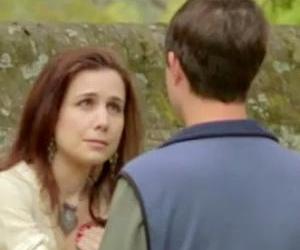
Love on the spectrum: How autism brought one couple together
Lisa Bonos
Email successfully sent
close window“Pssst!”
With that one syllable, Dave Hamrick can tell how his wife is feeling. It might be a confident “pssst” if she’s happy; a quiet, deflated one if she’s feeling sad.
“An enthusiastic one would be like pssssssssssssssssssssssssssssst,” he demonstrates, in a psst that lasts several seconds. “That means she’s interested in a little more than just cuddling,” Hamrick says with a smile.
Like many couples who have been together for a while, Hamrick and Lindsey Nebeker have, over the years, figured out how to best communicate with each other and coexist in the same space. They’ve had to work at it, as they both have autism spectrum disorder, a neurological condition that can make communication, and social and emotional interaction more complicated and difficult.
Nebeker gets startled easily, so they came up with a system: Whenever one of them enters a room in their Alexandria townhome, they announce their presence with that simple psst and then wait for a response.
Hamrick, 35, and Nebeker, 34, are featured in the documentary “Autism in Love,” which peers into the lives of four autistic adults as they seek or maintain romantic relationships. The film premieres on Monday as part of the PBS series “Independent Lens,” and in its first few moments Hamrick is featured saying he never knew for sure if he would get married someday.
Nebeker was also unsure about marriage, she tells me in the couple’s living room, adding that being part of the documentary made her think more seriously about their relationship. “Some of these sit-down interviews,” filmed over the span of a year, “were just like couple’s therapy,” Nebeker says. “Because the interviews were quite intensive, I think our relationship really evolved from that.”
“It did — it grew,” Hamrick adds.
Dave Hamrick, 35, and his wife, Lindsey Nebeker, 34, at their home in Alexandria, Va. The couple, who are both on the autism spectrum, are part of the “Autism in Love” documentary airing on PBS. (Photo by Ricky Carioti/The Washington Post)
“Pssst!”
With that one syllable, Dave Hamrick can tell how his wife is feeling. It might be a confident “pssst” if she’s happy; a quiet, deflated one if she’s feeling sad.
“An enthusiastic one would be like pssssssssssssssssssssssssssssst,” he demonstrates, in a psst that lasts several seconds. “That means she’s interested in a little more than just cuddling,” Hamrick says with a smile.
Like many couples who have been together for a while, Hamrick and Lindsey Nebeker have, over the years, figured out how to best communicate with each other and coexist in the same space. They’ve had to work at it, as they both have autism spectrum disorder, a neurological condition that can make communication, and social and emotional interaction more complicated and difficult.
Nebeker gets startled easily, so they came up with a system: Whenever one of them enters a room in their Alexandria townhome, they announce their presence with that simple psst and then wait for a response.
Hamrick, 35, and Nebeker, 34, are featured in the documentary “Autism in Love,” which peers into the lives of four autistic adults as they seek or maintain romantic relationships. The film premieres on Monday as part of the PBS series “Independent Lens,” and in its first few moments Hamrick is featured saying he never knew for sure if he would get married someday.
Nebeker was also unsure about marriage, she tells me in the couple’s living room, adding that being part of the documentary made her think more seriously about their relationship. “Some of these sit-down interviews,” filmed over the span of a year, “were just like couple’s therapy,” Nebeker says. “Because the interviews were quite intensive, I think our relationship really evolved from that.”
“It did — it grew,” Hamrick adds.
The pair met at an autism conference in Nashville in 2005 and dated long distance for the first two years. “I felt safer that way,” Nebeker says of the distance, “that we could take things a little more slow.” They’re very different people: Nebeker is more of an artistic and verbal person; Hamrick is more of a scientist. The main thing bringing them together, they say, is their shared disability. Even though it manifests differently for each of them, they can draw on shared experiences and challenges. “If you’re having frustrations over something, or having a concern or problem — and I may not have those feelings at the same time, or maybe it’s not an issue I have,” Nebeker says. “But at least I understand why you’re experiencing those emotions or feelings, because that’s part of autism.”
To continue reading this article on the Washington Post, click here
Autism in Love: Trailer Dave Hamrick, 35, and his wife, Lindsey Nebeker, 34, both on the autism spectrum, are part of the “Autism in Love” documentary airing on PBS.
Related Articles
Hillary Clinton's autism plan suggests times are changing
Hillary Clinton’s got an autism plan, the only candidate so far to release one. Indeed, when I reached out t ..
Taking antidepressants during pregnancy linked to increased risk of autism
Children are more likely to be diagnosed with autism if their mothers took antidepressants during pregnancy, a ..
Autism finds a friend on Sesame Street, new character created
A series of new videos from Sesame Street star a Muppet with a magic wand, pink wings and friends with autism. ..

